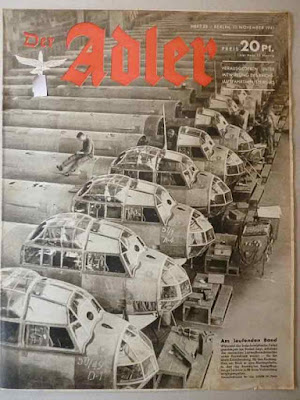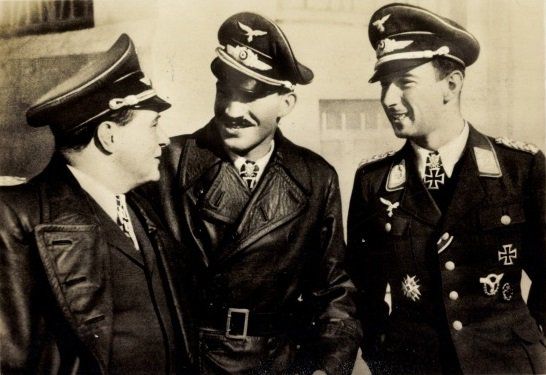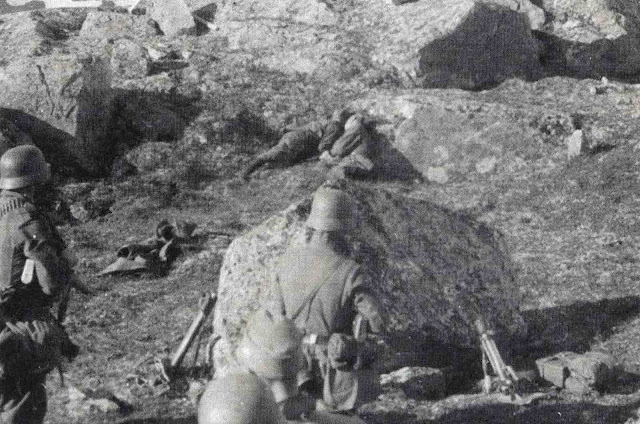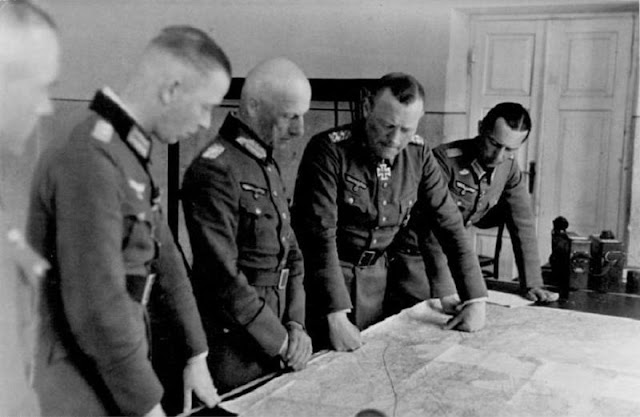Sunday 29 June 1941
 |
| Marshal CGE Mannerheim discusses strategy with the hero of the Winter War General Talvela, at the beginning of Finland’s second war with the USSR during WWII, the Continuation War. |
Eastern Front: As of
29 June 1941 is one week into Operation Barbarossa, and the invasion is going right on schedule for Germany. The biggest success so far has been the capture of Minsk, the largest city on the high road to Moscow. Today, the Germans also clean up their supply route to Minsk by eliminating Soviet resistance at the Brest Fortress. If anything, the German success is greater than expected - which provides Hitler with his first real chance to interfere with operations.
The Soviets issue a directive - the first of many - aimed at punishing cowardice and desertion. The NKVD is instructed to set up posts behind the lines and apprehend any troops retreating without authorization. Summary courts-martial are established that have the authority to impose the severest penalties on soldiers and civilians alike.
In the Far North, Finland finally launches its first offensive in conjunction with Wehrmacht troops commanded by the hero of Narvik, Eduard Dietl. The overall Finnish military commander is Field Marshal Baron Carl Gustaf Emil Mannerheim, a legendary World War I leader.
As part of larger Operation Silver Fox (German:
Unternehmen Silberfuchs; Finnish: Operation
Hopeakettu), Operation Platinum Fox aims to take the USSR's only ice-free port available to western supply convoys, Murmansk. The German Army of Norway and the Finnish forces must cross very rugged terrain before reaching the port. The Finnish 3rd and 6th Divisions are attached to the German forces and nominally under their command, and they face Soviet 14th Army and 54th Rifle Division. The 3rd Mountain Division advances through the Titovka Valley and secures a key bridge over the river in the valley, while the 2nd Mountain Division takes the neck of the Rybachy Peninsula.
The main Finnish objective during all these attacks, as always during the Continuation War, is the recovery of Finnish territory lost as a result of the Winter War. Finnish 18th Division (Colonel Pajari) advances into Enso, a formerly Finnish town just across the border. The Soviets put up fierce resistance, and elsewhere the operation is hampered by German troops who are unfamiliar with the terrain and the climate. The Soviets land reinforcements on Fisherman's Peninsula. The German advance slows and then stops very quickly.
 |
| Gebirgsjäger of 7th Company/II. Bataillon/137th Regiment in Norway. From left to right: Franz Hollerweger, Feldwebel Kepplinger, and Gefreiter Josef Köchl. Köchl perished died on 29 June 1941 during a battle near the village of Titovka, Murmansk Oblast. |
In the Army Group North sector, the Soviets are in disarray. Stalin recalled General of the Army Dimitri Pavlov and his entire staff on the 28th and replaced him with General Andrey Ivanovich Eremenko. Eremenko arrives at the Western Front headquarters at Mogilev in the morning to hear that the German 3rd Panzer Division has captured a bridgehead over the Berezina at Bobruisk and other panzers are across the Dvina at Riga. Considering that the plan was for the Soviet 4th Army to make a stand on the Berezina, this creates a dangerous situation. The Stavka rushes the elite 1st Moscow Motor Rifle Division to Borisov to try to hold the line.
General Timoshenko, who has virtually taken over command of the Northwestern Front from General Kuznetsov, orders a stand on the Velikaya River. The Stavka now for the first time becomes concerned about the defense of Leningrad and hopes to make a successful defense of the city on the Stalin Line.
The Wehrmacht seizes the port of Libau after overcoming a fierce Soviet defense. The Germans take many casualties, and the fighting only ends when the defending Soviet 67th Rifle Division runs out of ammunition.
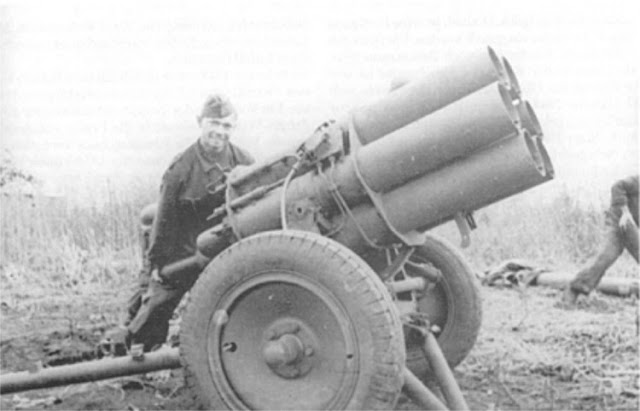 |
| A 15 cm Nebelwerfer 41 rocket of the type used at Brest Fortress. Introduced in 1940, it fired from six pipes and the shots could travel 5500 meters. |
The Soviets at Brest Fortress in Brest-Litovsk remain dug in when the day begins. The Wehrmacht has used an assortment of advanced weaponry, including 15 cm Nebelwerfer 41 rocket mortars and flamethrowers, but the Soviets are dug in and refusing to surrender. Today, the German 45th Infantry Division calls in air support and the Luftwaffe sends Junkers Ju 88 bombers twice during the day. They drop 3,970 lb (1,800 kg) "blockbuster" bombs, the maximum that the planes can carry and the heaviest dropped by the Luftwaffe during World War II. This does the trick, and the 360 Soviet defenders surrender. However, some isolated Soviet soldiers remain hidden in the ruins until 23 July, when a Soviet lieutenant is captured - and perhaps longer.
In the Army Group Center sector, Hitler is tired of simply watching the brilliant offensive unfold through the Baltic states. He decides to impose his will and do something similar to what he did just over a year ago - put a brake on the advance. Hitler has Commander-in-Chief of the German Army Walther von Brauchitsch order commander of Army Group Center Fedor von Bock to stop his panzers and consolidate his position. In the first of many such instances, the Wehrmacht complies with the order in form but not in substance. Von Bock quietly encourages General Guderian to continue sending his 2nd Panzer Group east toward Bobruisk. The continued advance is explained to Hitler as a "reconnaissance-in-force," though in reality the generals simply ignore him.
In the Army Group South sector, massive Soviet tank forces have done little to hurt the advancing panzers at the Battle of Brody. However, at the cost of hundreds if not thousands of tanks, the Soviets at least have slowed the panzers. Soviet 22nd Mechanized Corps (Major-General S.M. Kondrusev) reports that it is down to only 19% of the tanks with which it began the war. Major-General N.V. Feklenko's 19th Mechanized Corps reports that it has only 32 tanks remaining out of its starting force of 453 tanks. General Popel still has a large force of tanks, but he is trapped in Dubno and attempts by other Soviet forces have failed. German 16th Motorized, 75th Infantry Division, two other infantry divisions, and the 16th Panzer Division begin the process of reducing Popel's pocket.
Luftwaffe boss Hermann Goering, eager to burnish his own credentials with Hitler, claims:
In the first week of the campaign, the Luftwaffe has destroyed 4,990 Russian enemy aircraft for the loss of 175 of its own.
This, in fact, is not far from the truth if you count all of the Soviet aircraft destroyed on the ground. However, many of the Soviet planes destroyed were obsolete or non-combat planes. In any event, the USSR has thousands of planes further from the front.
 |
| US Army Air Force Lockheed A-29 Hudson, circa 1941 ( National Museum of the U.S. Air Force). |
Syrian/Lebanon Campaign: The British advance on Palmyra from Iraq continues today. Habforce's Arab Legion troops occupy Sukhna, which is about 40 miles northeast of Palmyra. The Vichy French notice this and prepare a counterattack. Right outside Palmyra, meanwhile, the Vichy French Foreign Legion drives the Wiltshire Yeomanry from a ridge overlooking the town and airfield.
In the Damour Valley east of Beirut, French artillery pounds British troops. British Brigadier William George Stevens keeps his main forces in the rear to avoid casualties but sends armed reconnaissance patrols to probe the French defenses.
From Paris, the government issues a communiqué:
The British Fleet has bombed our coastal positions in the Middle East. We have evacuated several of our bases in the mountains of southern Lebanon under cover of artillery fire which inflicted heavy losses on our assailants. Out aerial forces, supported by naval aircraft, repeatedly intervened in the ground fighting, especially around Palmyra (Syria). A British colonel and 40 men were captured.
As the communiqué suggests, there continues to be very hard fighting in the mountains east of Beirut.
The RAF stages a rare assassination mission aimed at Vichy French General Henri Dentz, bombing his official residence. Dentz escapes injury. The French Havas News Agency quickly issues a communiqué:
This afternoon British aircraft bombed and destroyed the residence of the French High Commissioner in Beirut. There were large numbers of dead and wounded.
Events throughout World War II will establish that it is extremely difficult to kill a specific person with aerial bombing. Generally, to be successful, such operations must isolate the target and kill him directly rather than sending bombers over a particular house or town.
Offshore, Royal Navy light cruiser HMS Naiad and two accompanying destroyers bombard Damur during the night.
European Air Operations: RAF Bomber Command attacks Bremen (106 aircraft) and Hamburg (28) during the night, losing six planes.
Battle of the Baltic: The Luftwaffe bombs and sinks Estonian freighter Märta at Ventspils.
Finnish minelayers lay mines off the Soviet coast.
 |
| U-103, a Type IXB U-boat. It mistakenly sinks friendly Italian freighter Ernani on 29 June 1941 (Federal Archives Bild 101II-MW-3930-23A). |
Battle of the Atlantic: A running battle which began on 23 June continues in the North Atlantic around Convoy HX-133. Both sides have taken losses, with the Allies' losses "expected" and the German wolfpack losses a little less so. The Allies have reinforced HX-133 due to Ultra intercepts to a total of 13 escorts, much greater than usual at this stage of the war.
U-651 (Kptlt. Peter Lohmeyer), on its first patrol due south of Iceland, participates in the HX-133 attacks. It torpedoes and sinks 6342-ton British freighter Grayburn. There are 18 survivors, including master John Williams Sygrove, while 35 men perish.
U-651 then is sunk during a depth charge attack by British destroyers HMS Malcolm and HMS Scimitar, the British corvettes HMS Arabis and HMS Violet and the British minesweeper HMS Speedwell. The U-boat has enough time to surface and disgorge its entire crew of 45 men before it sinks.
U-651 only went on one patrol. It sank two ships during the patrol totaling 11,639 tons. Royal Navy Intelligence interviews the crew and writes up an extremely uncomplimentary summary of them, including the following:
The First Lieutenant, Oberleutnant zur See (Lieutenant) Karl Josef Heinrich, was an extremely unpleasant person, uncouth and ill-informed, and made every effort to be a general nuisance; both he and the Engineer Officer (Engineer Lieutenant) Benno Brandt, believed that they were furthering the cause of Hitler’s New Order by making innumerable minor complaints and by attempting to bully sentries and others who were unfortunate enough to have to come into contact with them.
The obviously annoyed British interrogators note in the report that the captives incessantly quote "propaganda" and "apparently had very little home-life or parental influence." They note further that the prisoners "alleged that the prostitutes of Lorient knew more about past and present plans than many German officers," and that the French at Lorient secretly worked against the Germans.
U-564 (KrvKpt. Reinhard Suhren), on its first patrol out of Kiel, is operating in the northern convoy routes when it spots an independent freighter. It torpedoes and sinks 1215-ton Icelandic freighter Hekla. There are seven survivors who spend ten days on a raft, but one man perishes right after they are picked up by HMS Candytuft. Another survivor is so badly wounded that he spends six months in a hospital. In total, there are 14 deaths.
U-103 (KrvKpt. Viktor Schütze), on its fourth patrol out of Lorient, is operating about 450 miles west of Las Palmas when it spots a freighter. After an eight-hour chase and missing with a torpedo late on the 28th, U-103 finally torpedoes and sinks the ship at 00:51 on the 29th. Schütze surfaces and questions some of the survivors in a lifeboat and learns that he sank an Italian blockade runner, 6619-ton freighter Erani, which was disguised as Dutch freighter Enggano. So, this was a case of friendly fire. Ernani was trying to escape being interned at Teneriffe and make it to Bordeaux, so it had not told Italian authorities about its route. Schütze had no reason to think it was a friendly ship and did not get in any trouble for sinking an ally's ship.
U-123 (Kptlt. Reinhard Hardegen), on its fifth patrol out of Lorient and operating about 200 miles southeast of the Azores, spots Convoy SL-78. At 19:36, Hardegen hits 4088-ton British freighter Rio Azul. The ship breaks in two and sinks within minutes. There are 33 deaths, including the master, while 15 crew survive and are picked up by HMS Esperance Bay.
 |
| U-66 at Lorient. It sank two Greek freighters near the Canary Islands on 29 June 1941. |
U-66 (Kptlt. Richard Zapp), on its second patrol out of Lorient, also spots Convoy SL-78 west of the Canary Islands. Zapp torpedoes and sinks two Greek freighters:
- 4345-ton freighter George J. Goulandris
- 5686-ton freighter Kalypso Vergotti.
The Vergotti was a straggler and thus easier to attack than the Goulandris. Everyone on both ships survives.
The Luftwaffe bombs and sinks 626-ton British freighter Cushendall a few miles off Stonehaven. There are two deaths.
The Luftwaffe bombs and damages 6142-ton British freighter Silverlaurel at King George Dock, Hull. There are no casualties.
The Luftwaffe bombs and damages 7457-ton British freighter Empire Meteor off Cromer. The Empire Meteor makes it to the Humber in tow.
The Luftwaffe bombs and damages 486-ton British freighter Empire Larch off Great Yarmouth. The Empire Larch makes it to Great Yarmouth under its own power.
Norwegian 6118-ton tanker Leiesten hits a mine and is damaged in the Barrow Deep (north of Margate). The ship is taken in tow and makes it to Gravesend.
A US excursion boat, the Don, founders under mysterious circumstances in heavy fog off Ragged Island, Casco Bay, Maine. There are 34 deaths. It is unclear what happened, but one theory is that the engine exploded.
US Navy Task Group 2.8, led by the aircraft carrier USS Yorktown (CV-5) and heavy cruisers USS Quincy (CA-39) and USS Vincennes (CA-44), departs Hampton Roads, Virginia for a neutrality patrol.
Royal Navy destroyer HMS Croome (Lt. Commander John D. Hayes) is commissioned.
Canadian corvette HMCS Kenogami (Lt. Commander Reginald Jackson) is commissioned.
Battle of the Mediterranean: Royal Navy destroyer HMAS Waterhen is making a nightly run to Tobruk when its luck runs out. A Regia Aeronautica Junkers Ju 87 bombs Waterhen about 100 miles east of Tobruk. The destroyer is taken in tow by HMS Defender, but Waterhen sinks on the way back to Alexandria. There are no casualties.
Royal Navy submarine HMS Urge makes an unsuccessful attack on Italian heavy cruiser Gorizia south of Messina, Sicily. While Urge's crew claims two hits and explosions, apparently Gorizia is undamaged. Gorizia and other ships then attack Urge, but it escapes. Royal Navy submarine Utmost attacks the same ships, also unsuccessfully.
Operation Railway II, another airplane ferrying mission to Malta by Force H out of Gibraltar, heads toward the island.
German/Soviet Relations: At some point during this week - details are very sketchy - Soviet Premier Joseph
Stalin attempts to broker a peace deal with Hitler through a Bulgarian diplomat, Ivan Stamenov. Foreign Minister Molotov has Lavrentiy Beria arrange this by using one of Beria's subordinates, NKVD officer Pavel Sudoplatov, who has a "casual" lunch at a Moscow restaurant with the diplomat. Sudoplatov explains to Stamenov what to say to Hitler. Stalin is willing to offer huge concessions for peace, including Ukraine and all of the areas granted to him in the "secret protocol" to the 23 August 1939 Molotov/Ribbentrop Pact in the Baltic States. Stalin does, though, demand to know why Hitler invaded the USSR.
Hitler turns Stalin down flat and will not even consider the offer. This is one of Hitler's biggest mistakes. These revelations were hidden for many years but came to light during the period after Stalin died from natural causes in the 1950s. There are few other details of this little-known incident, but there is no reason to doubt that it happened. This peace offer was classified as treason and was one of the charges used to condemn Beria to death. The others involved - including the Bulgarian Stamenov diplomat used as the go-between - submitted affidavits confirming the incident. Sudoplatov confessed to it under interrogation and also was convicted of treason, serving 15 full years in prison (yes, there are many questions about the validity of such "proof," but there was a lot of corroboration). Molotov was never tried for treason despite his deep role in the incident, but gradually fell out of favor, lost his positions one by one, and by 1962 was a "non-person" in the Soviet bureaucracy.
German/Spanish Relations: Spanish leader Francisco Franco has agreed that German U-boats may receive supplies in Spanish waters as long as it is done in a low-key way. One such instance happens today when U-69 (Kptlt. Jost Metzler) refills its tanks from an interned German tanker, Charlotte Schliemann, which is berthed at Las Palmas de Gran Canaria harbor, then departs. The entire incident happens in the early morning hours so that nobody will notice.
Italian/Yugoslavian/Albanian Relations: Italy annexes to its puppet state of Albania districts of Yugoslavia that are adjacent to Albania.
Finnish Military: Finland forms Karelian Army (Karjalan Armeija) for operations in northern Karelia.
 |
| Lord Beaverbrook and Winston Churchill. |
British Government: Lord Beaverbrook, formerly Minister of Aircraft Production and then briefly Minister of State, is appointed Minister of Supply. Beaverbrook is a close confidant of Winston Churchill, somewhat akin to the relationship that Harry Hopkins has to President Franklin Roosevelt and a key figure in England's wartime economy.
German Government: Hitler issues a secret decree which formally named Hermann Göring his successor in the event of his death. It gives Göring the power to act as Hitler's deputy with freedom of action in the event Hitler ever loses his freedom of action—either by way of incapacity, disappearance or abduction.
Romanian Government: Exiled King Carol II arrives in Mexico and establishes his residence there for the remainder of the war. He claims to be the leader of a government-in-exile but receives no recognition or support for the same.
China: The Japanese bomb Chungking (Chongqing), hitting the British Embassy and US gunboat USS "Tutuila" at Lungmenhao lagoon.
Holocaust: The pogrom in Jassy (Iasi), Romania continues. Local Romanian forces round up 5000 Jews for transport to concentration camps in sealed cattle trucks. The Romanian forces beat down doors and kill an estimated 260 Jews today, with thousands ultimately killed.
Soviet Homefront: The Soviet government begins evacuating 212,000 children from Leningrad. The government broadcasts a "scorched earth" policy, asking citizens to leave "nothing" for the Germans.
 |
| The burial of Ignacy Paderewski at Arlington National Cemetery, 1941. |
American Homefront: Ignacy Jan Paderewski, Polish pianist, composer, and politician, passes away in New York at the age of 80. President Roosevelt announces that the body will rest for a short viewing period at Arlington National Cemetery at the USS Maine Monument. Roosevelt comments, "He may lie there until Poland is free," a wish that is granted; Paderewski's remains remain there until the fall of the Soviet Union and are only flown to Warsaw on 26 June 1992.
Former President Herbert Hoover gives a
radio speech over the NBC network. It follows a speech he gave in May, and he notes:
In these six weeks, opposition against joining in this war has grown stronger in the American people. Yet we have moved officially nearer to war.
Hoover spends a large part of his speech discussing Japan. He notes that it "cannot make an effective air attack upon us," though it "could do some terrorization." He urges preparing for war in order to avoid having to declare war on Japan or Germany and urges that Roosevelt "Stop this notion of ideological war to impose the four freedoms on other nations by military force and against their will."
Hoover also raises a sensitive topic: communism:
If we go further and join the war and we win, then we have won for Stalin the grip of communism on Russia.... If we join the war and Stalin wins, we have aided him to impose more communism on Europe and the world.
Hitler similarly views the war as a struggle against war communism... in addition to being his means to global hegemony.
New York Yankee Joe DiMaggio plays a doubleheader at Griffith Stadium in Washington, D.C. He gets a hit in the first game to extend his club-record hitting streak to 41 games. Between games, someone apparently steals his bat (a 36-ounce Louisville Slugger), and he goes hitless in his first three at-bats in the second game. Then, however, DiMaggio recalls that he lent an identical bat to right fielder Tommy Henrich earlier in the season. After getting the bat back, DiMaggio gets a hit in the seventh inning. This extends DiMaggio's hitting streak to 42 games - breaking George Sisler's major league record of 41 games set in 1922. Sisler, who is in attendance, comments "I'm glad a real hitter broke it."
 |
| Superman Sunday comics, 29 June 1941. |
June 1941 June 1, 1941: Farhud PogromJune 2, 1941: Massacres on CreteJune 3, 1941: Kandanos MassacreJune 4, 1941: Kaiser Wilhelm Passes AwayJune 5, 1941: Death in ChungkingJune 6, 1941: Hitler's Commissar OrderJune 7, 1941: Commandos Strike at PessacJune 8, 1941: British Invade Syria and LebanonJune 9, 1941: Litani River BattleJune 10, 1941: British Take AssabJune 11, 1941: Hitler Thinking Beyond RussiaJune 12, 1941: St. James AgreementJune 13, 1941: Lützow DamagedJune 14, 1941: Latvian June DeportationsJune 15, 1941: Operation BattleaxeJune 16, 1941: The Old LionJune 17, 1941: British Spanked in North AfricaJune 18, 1941: Turkey Turns Its BackJune 19, 1941: Cheerios IntroducedJune 20, 1941: Birth of US Army Air ForceJune 21, 1941: Damascus FallsJune 22, 1941: Germany Invades RussiaJune 23, 1941: A Soviet KV Tank Causes HavocJune 24, 1941: Kaunas and Vilnius FallJune 25, 1941: Finland Declares WarJune 26, 1941: Bombing of KassaJune 27, 1941: Encirclement At MinskJune 28, 1941: Minsk FallsJune 29, 1941: Brest Fortress FallsJune 30, 1941: Mölders Becomes Top Ace2020





